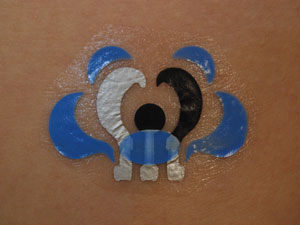Scientists in the US have developed an electrochemical sensor incorporated into a temporary transfer tattoo (T3) to be used as a device to warn the wearer of any health or security threats. Not only is the sensor non-invasive, it can also be concealed in an inconspicuous tattoo design, without compromising its resolution or performance.
Joseph Wang and his colleagues from the University of California, San Diego, have combined their expertise in printing flexible chemical sensors with commercially-available temporary tattoo paper. Integrating the electrochemical sensor within T3 maximises its contact with skin, including all epidermal irregularities, thanks to the elasticity of the T3 material. In addition to this, the team dispersed carbon fibre (CF) segments into the tattoo ink, providing an interlinked conductive backbone that enhances the sensor’s electrochemical behaviour. The CF constituents also help to counteract cracking and provide the mechanical reinforcement needed to protect the sensor against routine wear-and-tear while on the skin. The team also showed that the T3 sensor (on pig skin) could be used for detecting explosives like 2,4,6-trinitrotoluene (TNT), in connection with square wave voltammetry.
Read the full article in Chemistry World
Link to journal article
Electrochemical Sensing Based on Printable Temporary Transfer Tattoos
Joseph Wang
Chem. Commun., 2012, Accepted Manuscript, DOI: 10.1039/C2CC32839A, Communication











